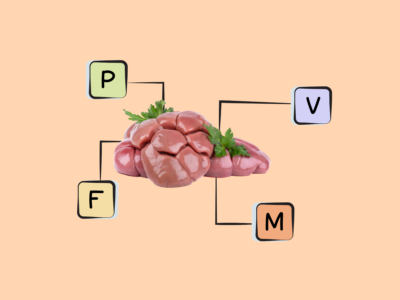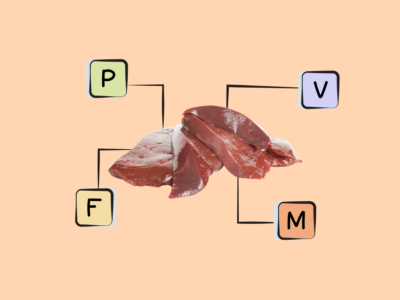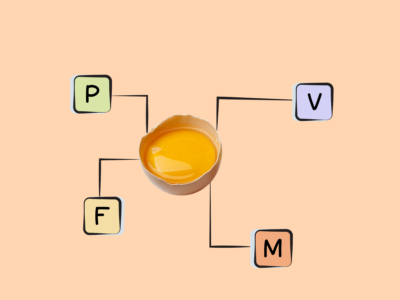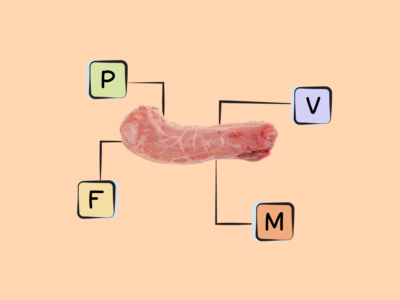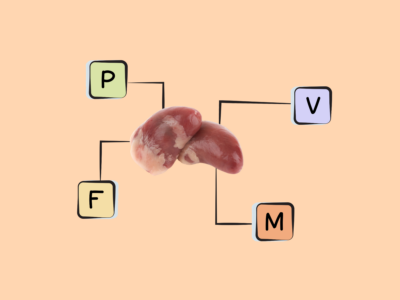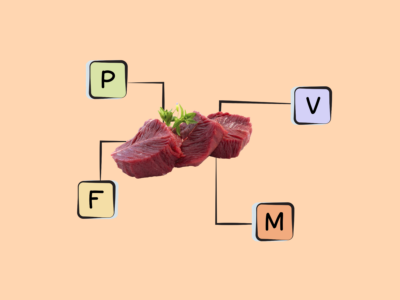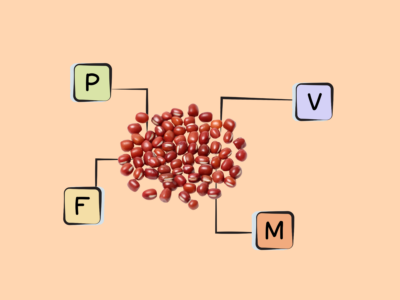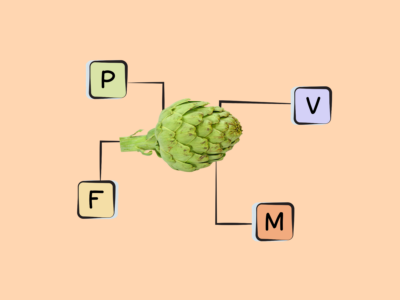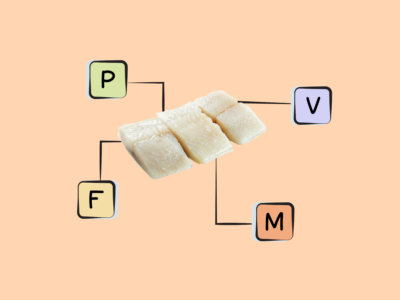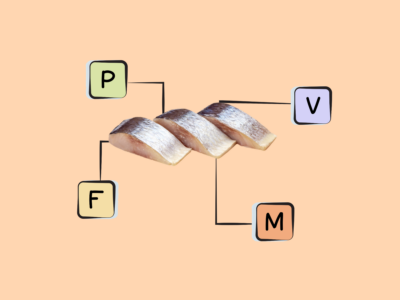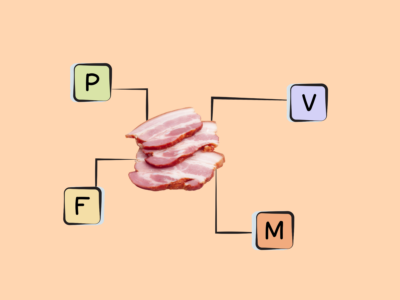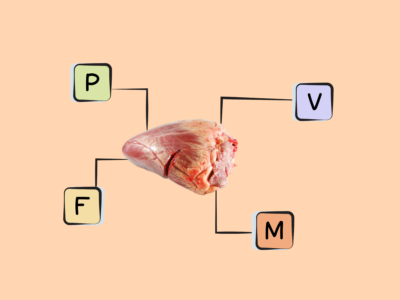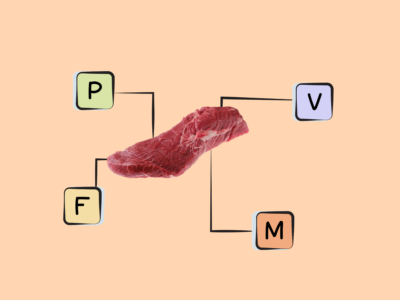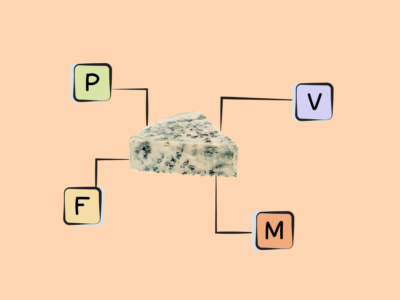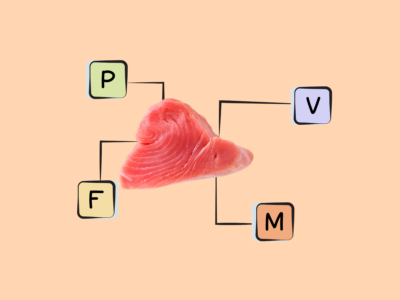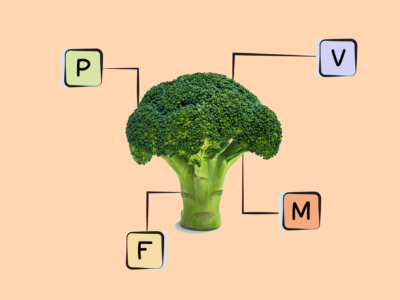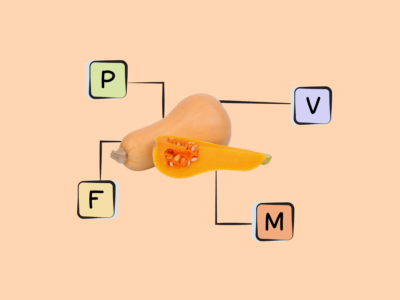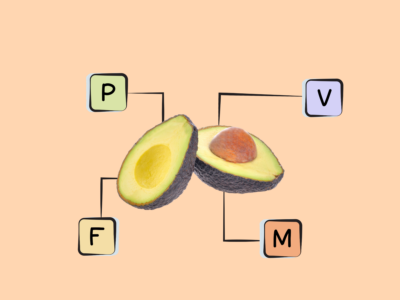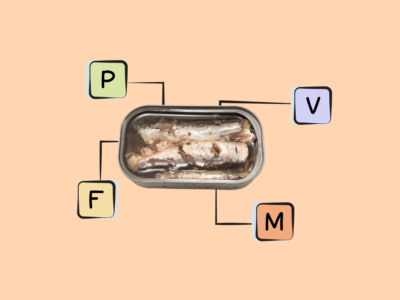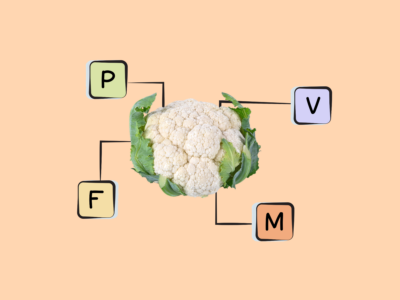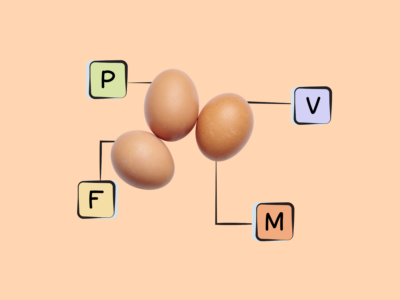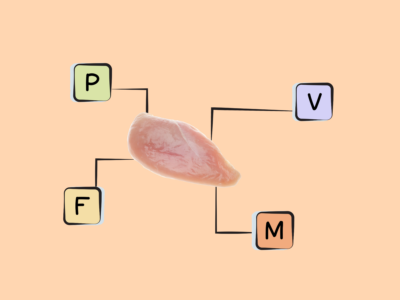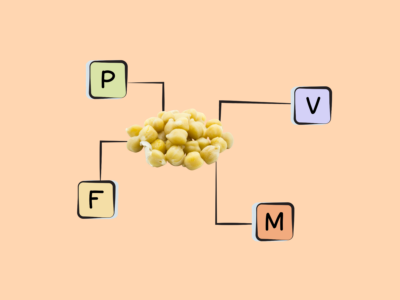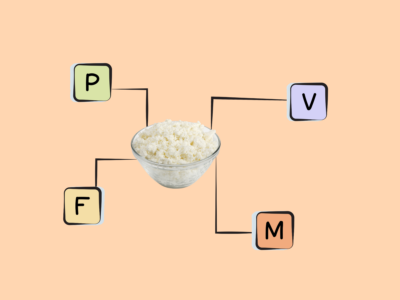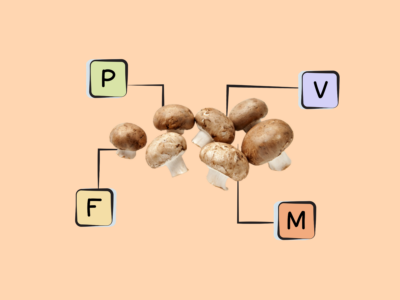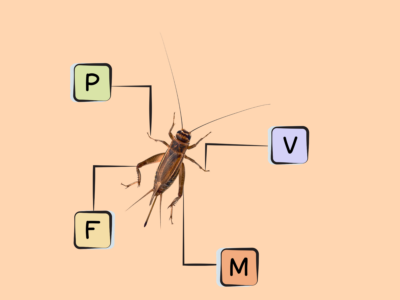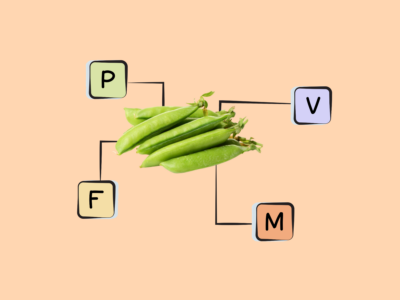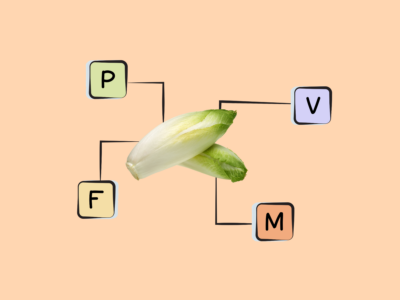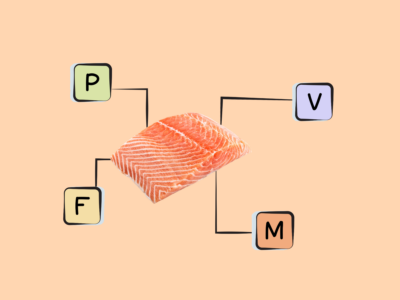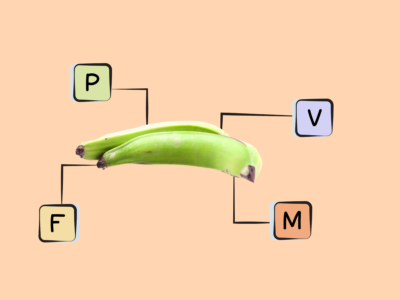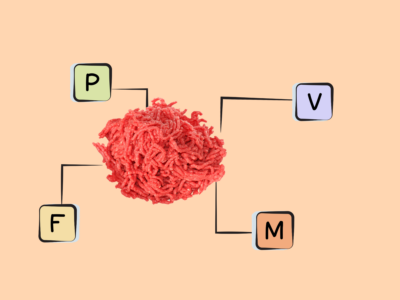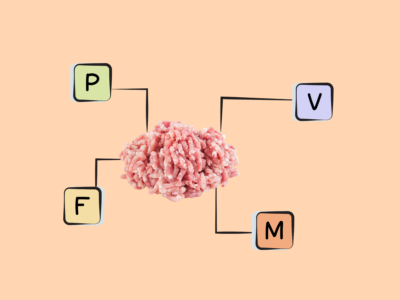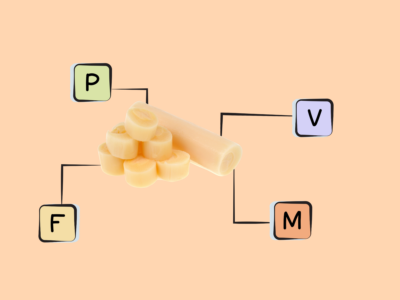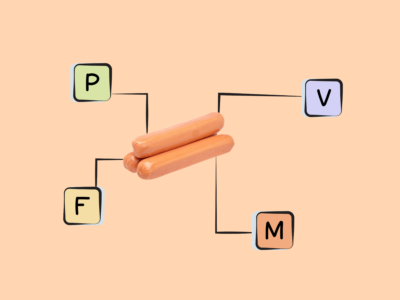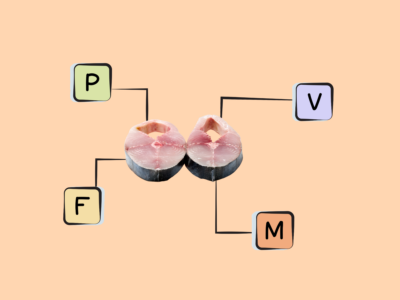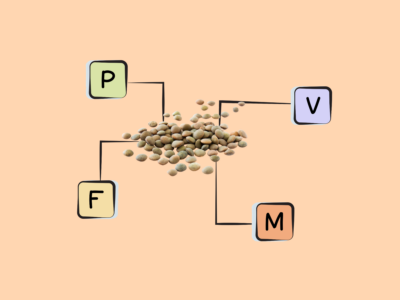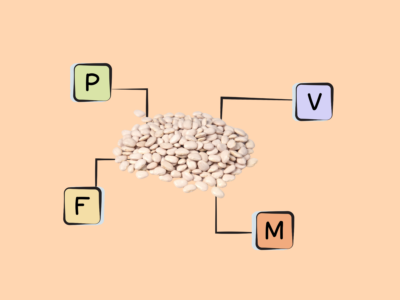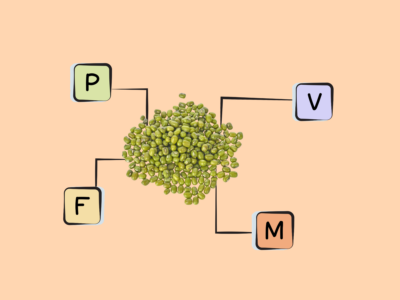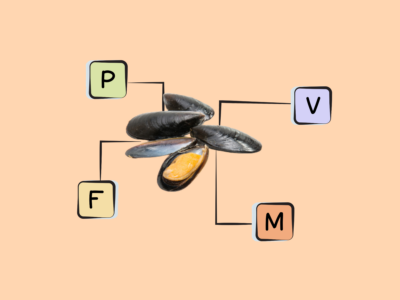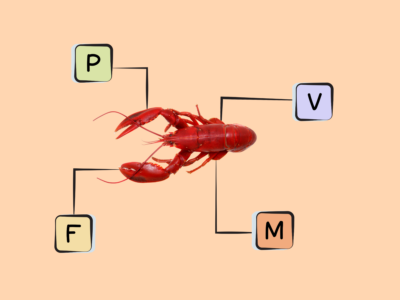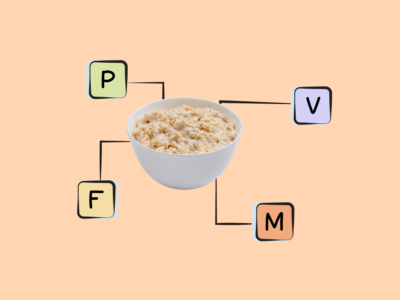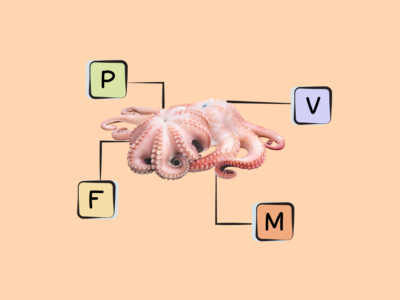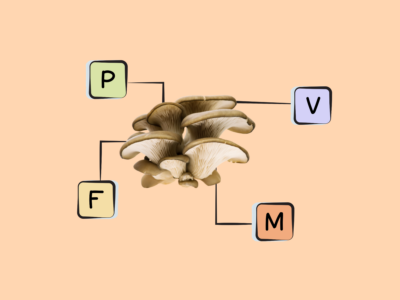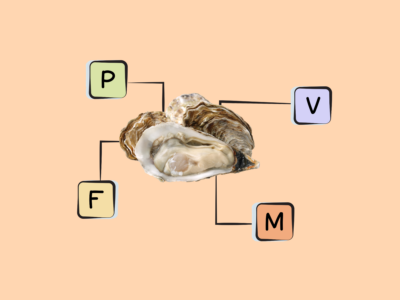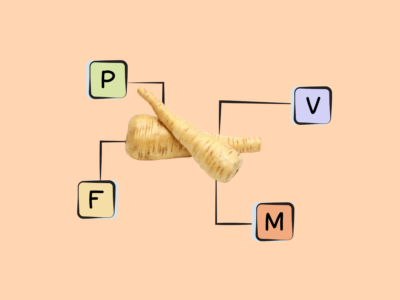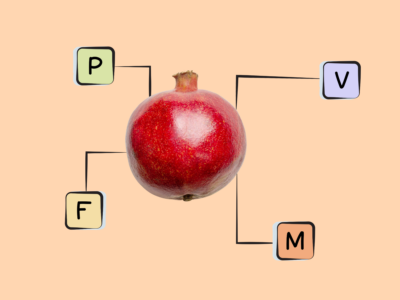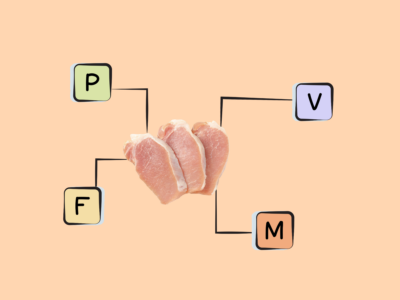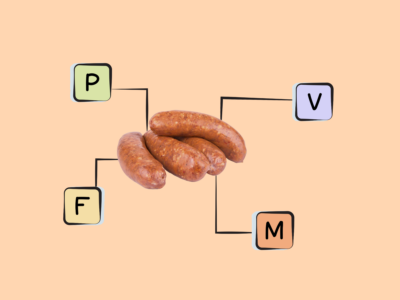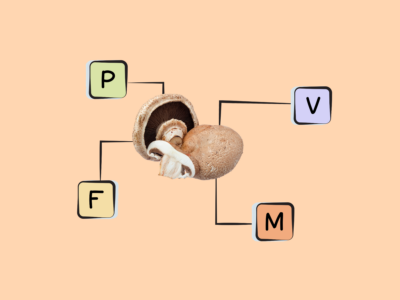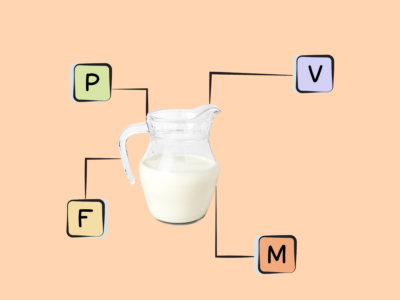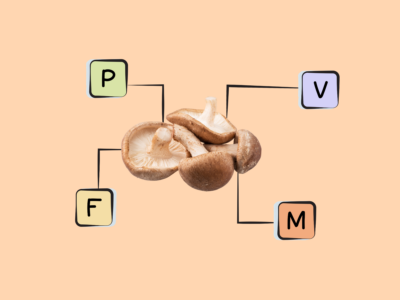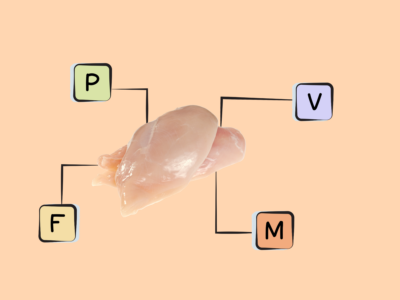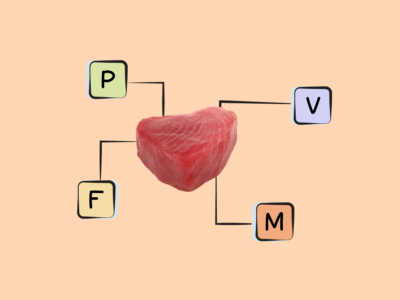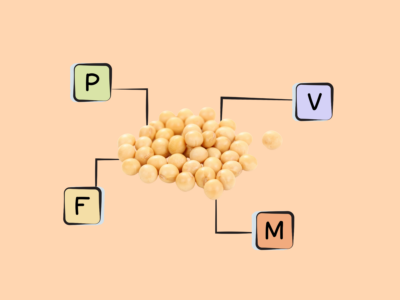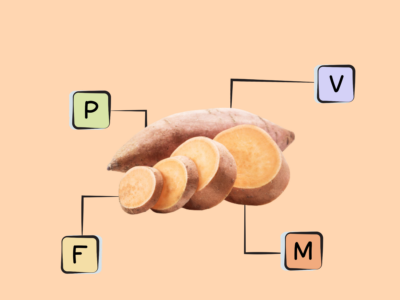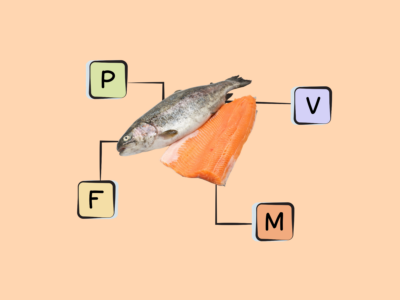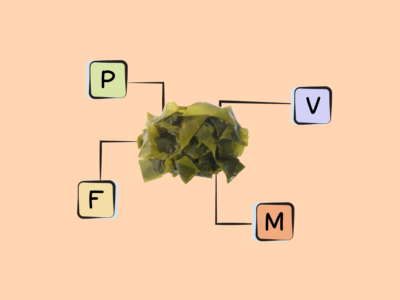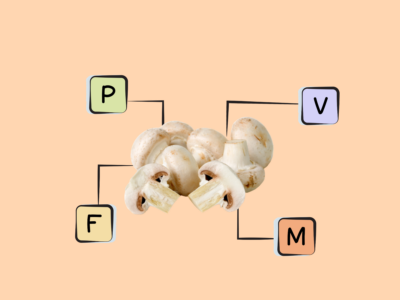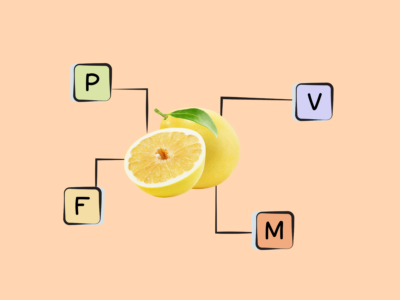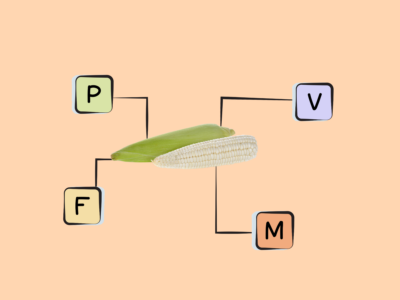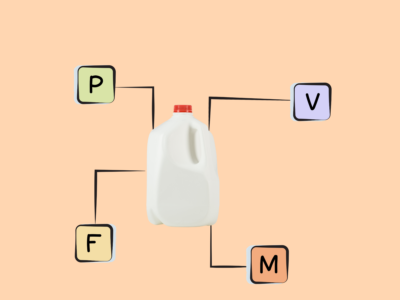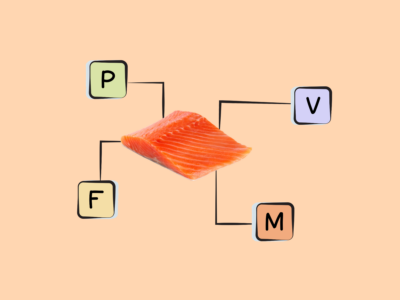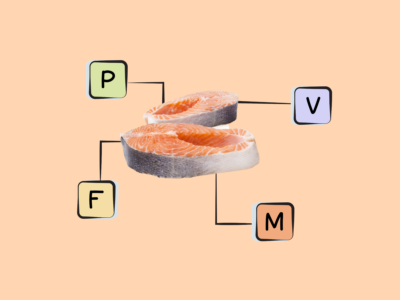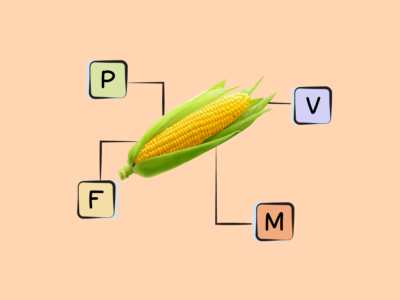Key Takeaways (expand)
- Pantothenic acid, also called vitamin B5, is a water-soluble B vitamin that exists in almost every food (plant and animal alike!).
- Pantothenic acid can be synthesized from pantoic acid and the amino acid beta-alanine.
- Pantothenic acid serves as a precursor for coenzyme A, which is essential to numerous life-sustaining biological reactions in the body.
- Specifically, coenzyme A is needed to metabolize a variety of drugs and toxins, as well as to create a bioactive lipid called sphingosine.
- In the form of its derivatives acetyl-CoA and succinyl-CoA, coenzyme A is involved in synthesizing fatty acids, steroid hormones, cholesterol, the neurotransmitter acetylcholine, and vitamins A and D.
- Derivatives of coenzyme A are also needed for synthesizing melatonin and creating heme, a component of hemoglobin.
- Like other B vitamins, pantothenic acid is involved in energy metabolism: by helping create coenzyme A, it allows other molecules (such as pyruvate and for alpha-ketoglutarate) to enter the Krebs cycle and undergo transformation.
- Pantothenic acid may help maintain a healthy digestive tract, and can exert an antioxidant effect that helps combat low-grade inflammation.
- Within cells, pantothenic acid has been shown to boost the production of the master antioxidant glutathione.
- High-dose treatment with pantethine (a derivative of pantothenic acid that’s structurally similar to coenzyme A) can help normalize blood lipid profiles, including reducing LDL cholesterol, reducing apolipoprotein B, increasing HDL, and lowering the ratio of triglycerides to HDL cholesterol; in fact, it’s been proposed as an alternative to statins!
- Pantethine has also has been shown to reduce cholesterol oxidation, intimal thickening, lipid deposition, and fatty streak formation within the coronary arteries and aorta, further giving it a cardio-protective role.
- Pantothenic acid may help accelerate wound healing, due to raising the fibroblast content of scarring wounds and increasing the the number, distance, and speed of migrating cells into a wounded area.
- Preliminary research suggests that pantothenic acid could improve symptoms of rheumatoid arthritis, although the exact mechanisms aren’t fully known.
- Most people get enough pantothenic acid due to its widespread presence in foods, and its deficiency has mostly only been studied in animal experiments; the few human studies available suggest its deficiency can lead to painful burning and tingling in the feet, fatigue, insomnia, headache, and intestinal disturbances.
- The best sources of pantothenic acid include organ meats, red meat, shellfish, oily fish, dairy products, eggs, lentils and other legumes, mushrooms, avocados, seeds, and sweet potatoes.
Table of Contents[Hide][Show]
Pantothenic acid, also called vitamin B5, is a water-soluble B vitamin that can be synthesized from the amino acid beta-alanine and pantoic acid. Its status as an essential nutrient was first discovered in 1933, when an American biochemist named Roger J. Williams determined that it was needed in order for yeast to grow; three years after that, other researchers discovered it was also an essential factor for supporting growth and preventing dermatitis in chickens. The name pantothenic comes from the Greek word pantos, which means “from everywhere”—referring to the fact that pantothenic acid exists in almost every food (plant and animal alike!).
Like other B vitamins, it plays an important role in energy metabolism—breaking down the carbohydrates, fat, and protein we eat for use as fuel (hence why B-complex vitamins are often nicknamed the “energy vitamins!”), as well as neurotransmitter production, cellular function, and a wide variety of organ functions.
Although small amounts are present in a wide variety of foods, the richest sources of pantothenic acid include organ meats (especially liver and kidneys), red meat, shellfish, oily fish, dairy products, eggs, lentils and other legumes, mushrooms, avocados, seeds (especially sunflower seeds and flaxseeds), whole grains, and sweet potatoes. Some processed foods, especially breakfast cereals, are fortified with pantothenic acid.
Ready to Make Healthy Eating Feel Effortless?

Join the FREE 90-day Nutrivore90 Challenge and build lasting habits with no food rules, no guilt—just real progress.
- Weekly downloads, journal prompts, and reflection tools—all completely free.
- Focus on nutrient density, not restriction
- Nutrivore90 starts January 5th, 2026!
The Biological Roles of Vitamin B5 (Pantothenic Acid)
One of the major roles of pantothenic acid is in serving as a precursor for coenzyme A—which is essential to numerous life-sustaining biological reactions in the body. Coenzyme A is synthesized from pantothenic acid via a five-step process that also uses cysteine and four molecules of ATP. First, panthothenic acid is phosphorylated to 4’-phosphopantothenate, via an enzyme called pantothenate kinase; second, cysteine is added to 4’-phosphopantothenate with the help of an enzyme called phosphopantothenoylcysteine synthetase, resulting in the formation of 4′-phospho-N-pantothenoylcysteine; third, 4′-phospho-N-pantothenoylcysteine is transformed by the enzyme phosphopantothenoylcysteine decarboxylase to produce 4′-phosphopantetheine; fourth, 4′-phosphopantetheine is adenylated by the enzyme phosphopantetheine adenylyl transferase to form dephospho-CoA; and fifth, dephospho-CoA is phosphorylated by the enzyme dephosphocoenzyme A kinase to form—finally!—coenzyme A.
These complex steps lead to the creation of a truly important molecule! Coenzyme A is needed in order for the liver to metabolize a number of drugs and toxins, as well as for the creation of sphingosine—a bioactive lipid that helps regulate processes involved in cancer, wound healing, cardiovascular health, immunity, angiogenesis, and asthma. In the form of its derivatives acetyl-CoA and succinyl-CoA, coenzyme A is involved in synthesizing fatty acids, steroid hormones, the neurotransmitter acetylcholine, cholesterol, and vitamins A and D, while also participating in the fatty acid beta-oxidation pathway. And, derivatives of coenzyme A are needed for synthesizing the hormone melatonin, as well as for creating a component of hemoglobin called heme.
Like other B vitamins, it also plays an important role in energy metabolism—particularly the second stage of cellular respiration, called the Krebs cycle or citric acid cycle. The Krebs cycle is an incredibly important series of chemical reactions that all aerobic organisms use to generate energy, through an eight-step process taking place in a cell’s mitochondria. During this cycle, acetate (in the form of acetyl CoA) derived from carbohydrates, fat, or protein undergoes a series of redox, dehydration, hydration, and decarboxylation reactions to produce adenosine triphosphate (ATP), the energy currency for all cells—as well as the waste product carbon dioxide, and reduced forms of NADH and FADH2 (which can then be converted into yet more ATP in the last step of the Krebs cycle: oxidative phosphorylation in the electron transport chain). This is complex biochemistry, but the important part here is that there are a whole lot of chemical reactions required to produce energy for our cells, and B vitamins are essential for that process!
Pantothenic acid’s specific role in cellular respiration is in serving as a starting compound for coenzyme A, which then supports a number of functions in the Krebs cycle. In particular, coenzyme A is required for pyruvate to enter the cycle as acetyl-CoA (which then combines with oxaloacetate to form citrate, beginning the first step of the cycle), as well as for alpha-ketoglutarate to undergo transformation to succinyl-CoA (which then becomes the entry point for branched chain amino acids, propionate, and odd-chain fatty acids to enter the cycle).
Along with assisting in energy metabolism, this micronutrient helps maintain a healthy digestive tract, and may exert an antioxidant effect that helps combat low-grade inflammation. It’s even been shown to boost the production of glutathione (an extremely important antioxidant) within cells.
Interactions with Other Nutrients
Nutritionally, vitamin B5 has the potential (especially at high doses) to compete with biotin for uptake in cells and the intestines, due to both of these nutrients using the sodium-dependent multivitamin transporter.
Drug Interactions with Vitamin B5 (Pantothenic Acid)
Pantothenic acid has a handful of nutrient and drug interactions to be aware of.
Consuming high doses of pantothenic acid alongside blood-thinning drugs like warfarin or aspirin could also increase the risk of bleeding, and this nutrient can increase the effects of cholinesterase inhibitor drugs (which are used for treating Alzheimer’s disease), potentially causing side effects. Meanwhile, oral contraceptives containing estrogen and progestin might increase the body’s requirement for pantothenic acid. Pantothenic acid can also interfere with the absorption and effectiveness of the antibiotic tetracycline, making it important to take tetracycline and any pantothenic acid-containing dietary supplements at different times from each other.
Due to the potential risk of these interactions, it’s smart to seek medical advice from your health care provider before taking pantothenic acid supplements if you’re currently on any of the above medications!
Everything You Need to Jump into Nutrivore TODAY!

Nutrivore Quickstart Guide
The Nutrivore Quickstart Guide e-book explains why and how to eat a Nutrivore diet, introduces the Nutrivore Score, gives a comprehensive tour of the full range of essential and important nutrients!
Plus, you’ll find the Top 100 Nutrivore Score Foods, analysis of food groups, practical tips to increase the nutrient density of your diet, and look-up tables for the Nutrivore Score of over 700 foods.
Buy now for instant digital access.
Vitamin B5 (Pantothenic Acid) in Health and Disease
Vitamin B5 (pantothenic acid) has several noteworthy effects on health. Research suggests that a pantothenic acid derivative called pantethine (which is structurally similar to coenzyme A) has statin-like properties, helping improve blood lipid profiles and reducing other cardiovascular risk factors like cholesterol oxidation, intimal thickening, fatty streak formation, and lipid deposition within the arteries. This nutrient has also been shown to boost cellular production of the antioxidant glutathione, reduce inflammation, and potentially improve symptoms of rheumatoid arthritis. It can even help accelerate wound healing by increasing the migration of cells into injured tissue, as well as by increasing fibroblast content within the wound site.
Vitamin B5 and Cardiovascular Disease
Studies have shown cholesterol-lowering potential from high-dose treatment with pantethine—a derivative of pantothenic acid that’s structurally similar to coenzyme A, and that has the ability to inhibit cholesterol synthesis, accelerate fat metabolism, and be converted to cysteamine (a chemical compound that decreases LDL oxidation).
In multiple controlled trials, pantethine supplementation (600 – 900 mg daily) led to significantly improved blood lipid parameters, including reductions in LDL cholesterol, reduced apolipoprotein B, higher HDL, higher apolipoprotein A1, and a lower ratio of triglycerides to HDL cholesterol; it also has been shown to reduce cholesterol oxidation, and reduce intimal thickening, lipid deposition, and fatty streak formation within the coronary arteries and aorta. Its lipid-lowering properties are particularly strong among diabetics.
Due to its relative lack of toxicity, panthethine may be a useful alternative to statins and other cholesterol-lowering drugs that come with greater likelihood of side effects.
Vitamin B5 and Non-Alcoholic Fatty Liver Disease
Additional research suggests pantethine could also improve fatty liver disease. However, although this pantothenic acid derivative is generally well-tolerated, there have been some reports of diarrhea and elevated liver enzymes following its use, and it should only be taken under the guidance of a physician.
Vitamin B5 and Wound Healing
Pantothenic acid may also support wound healing. In animal models, pantothenic acid supplements increase the fibroblast content of scarring wounds during the fibroblast proliferation phase (laying the foundation for new extracellular matrix for granulation tissue and collagen), indicating an accelerated healing process. Similarly, in both human trials and in vitro experiments using human cells, the pantothenic acid derivatives calcium D-pantothenate and pantothenol have been shown to increase the number, distance, and speed of migrating cells into a wounded area (suggesting faster wound healing)—at least in part by inducing HMOX-1 expression and suppressing free radical formation in skin fibroblasts.
When combined with vitamin C, pantothenic acid may help increase levels of other nutrients involved in collagen synthesis (namely iron, copper, and manganese) following surgical injury, as well as help restore normal zinc levels at the surgical site (zinc being another important mineral for wound healing). This vitamin combination also increases the release of intracellular protein into the wound site.
Vitamin B5 and Rheumatoid Arthritis
On top of that, preliminary research suggests that pantothenic acid could improve symptoms of rheumatoid arthritis. People with this condition generally have lower blood levels of pantothenic acid compared to healthy individuals, with the lowest levels correlating with the most severe symptoms. While this alone doesn’t demonstrate cause and effect, other studies have shown that supplementing with the pantothenic acid derivative calcium pantothenate can improve rheumatoid arthritis symptoms, particularly morning stiffness and pain. However, the mechanisms behind these improvements aren’t clear, and more research on this topic is needed!
Vitamin B5 and Hair Color
Very limited evidence from animal models also suggests pantothenic acid could play a role in maintaining hair color: pantothenic deficient mice prematurely develop gray fur, and the graying is then reversed with pantothenic acid supplementation. However, there’s currently no evidence to support whether the same is true in humans!
Vitamin B5 and Fatigue
Some research supports a role of pantothenic acid in fatigue, though the findings are generally more robust in animal studies than humans. More research is needed!
Didn’t know vitamin B5 was this amazing? Maybe your friends will enjoy this too!
Health Effects of Vitamin B5 (Pantothenic Acid) Deficiency
Due to its widespread presence in foods, daily intake of pantothenic acid is adequate for nearly everyone, and deficiency in humans is rare—only occurring during severe malnutrition. As a result, most of our understanding of deficiency comes from animal experiments!
In rats, pantothenic acid deficiency results in damaged adrenal glands; in dogs, this deficiency results in low blood sugar, convulsions, rapid breathing, and increased heart rate; in monkeys, anemia occurs due to reduced synthesis of heme; in chickens, skin irritation, spinal nerve damage (associated with myelin sheath degeneration), and feather abnormalities occur; and in mice, pantothenic acid deficiency leads to lower exercise tolerance, reduced glycogen storage in the liver and muscle tissue, and graying fur.
In the few pantothenic acid deficiency experiments conducted in humans, resulting symptoms included numbness, painful burning and tingling in the feet, fatigue, insomnia, headache, and intestinal disturbances.
Nutrivore Is a Game-Changer—This FREE Guide Shows You Why
Sign up for the free Nutrivore Newsletter, your weekly, science-backed guide to improving health through nutrient-rich foods — without dieting harder —and get the Beginner’s Guide to Nutrivore delivered straight to your inbox!

How Much Vitamin B5 (Pantothenic Acid) Do We Need?
The recommended dietary allowance (RDA) for pantothenic acid is 5 mg per day for adults (6 mg per day during pregnancy, and 7 mg during breastfeeding/lactation); these amounts are based on observed dietary intakes in healthy populations. Even at high doses, little or no toxicity for this nutrient has been discovered, and there’s currently no official tolerable upper intake level.
Interestingly, along with being present in many food sources, certain gut bacteria are capable of synthesizing pantothenic acid—although it’s currently unknown how much of a contribution this makes to the body’s total pantothenic acid supply.
And, while adverse effects rarely occur from consuming high amounts of pantothenic acid, doses of 10 to 20 g per day have led to reports of mild diarrhea and upset stomach.
| 0 – 6 months | |||||
| 6 months to < 12 months | |||||
| 1 yr – 3 yrs | |||||
| 4 yrs – 8 yrs | |||||
| 9 yrs – 13 yrs | |||||
| 14 yrs – 18 yrs | |||||
| 19 yrs – 50 yrs | |||||
| 51+ yrs | |||||
| Pregnant (14 – 18 yrs) | |||||
| Pregnant (19 – 30 yrs) | |||||
| Pregnant (31 – 50 yrs) | |||||
| Lactating (14 – 18 yrs) | |||||
| Lactating (19 – 30 yrs) | |||||
| Lactating (31 – 50 yrs) |
Nutrient Daily Values
Nutrition requirements and recommended nutrient intake for infants, children, adolescents, adults, mature adults, and pregnant and lactating individuals.
Best Food Sources of Vitamin B5 (Pantothenic Acid)
The following foods have high concentrations of vitamin B5, containing at least 50% of the recommended dietary allowance per serving, making them our best food sources of this valuable B-vitamin!
Want to know the top 500 most nutrient-dense foods?
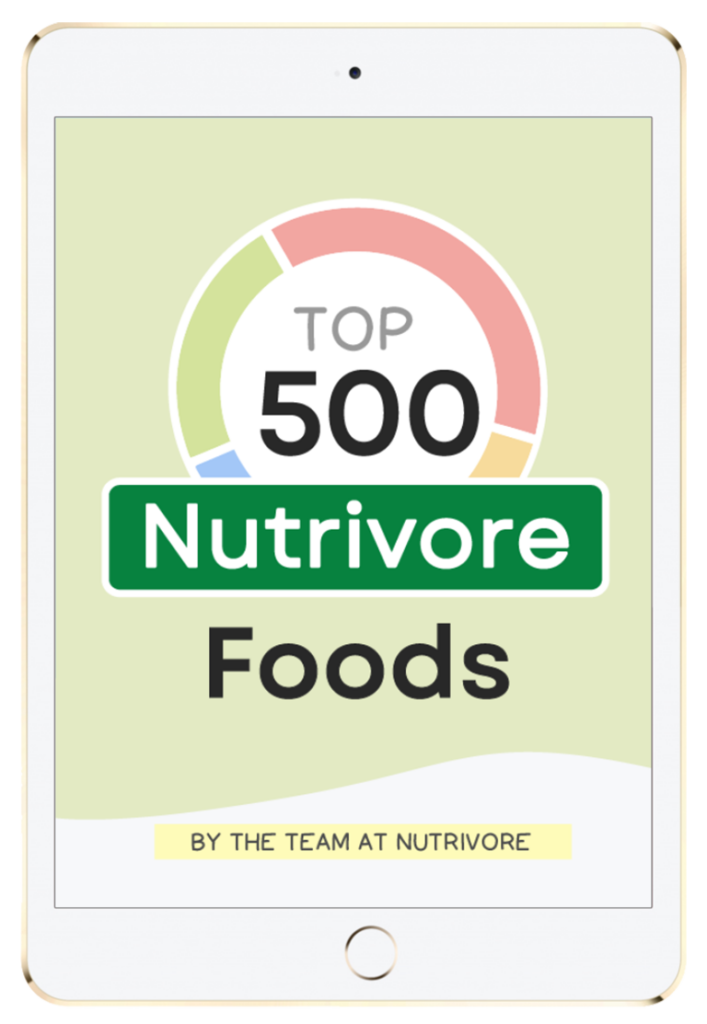
Top 500 Nutrivore Foods
The Top 500 Nutrivore Foods e-book is an amazing reference deck of the top 500 most nutrient-dense foods according to their Nutrivore Score. Think of it as the go-to resource for a super-nerd, to learn more and better understand which foods stand out, and why!
If you are looking for a quick-reference guide to help enhance your diet with nutrients, and dive into the details of your favorite foods, this book is your one-stop-shop!
Buy now for instant digital access.
Good Food Sources of Vitamin B5 (Pantothenic Acid)
The following foods are also excellent or good sources of vitamin B5, containing at least 10% (and up to 50%) of the daily value per serving.
Want to know the top 25 foods for this awesome nutrient?

The Top 25 Foods for Every Nutrient
The Top 25 Foods for Every Nutrient e-book is a well-organized, easy-to-use, grocery store-friendly guide to help you choose foods that fit your needs of 43 important nutrients while creating a balanced nutrient-dense diet.
Get two “Top 25” food lists for each nutrient, plus you’ll find RDA charts for everyone, informative visuals, fun facts, serving sizes and the 58 foods that are Nutrient Super Stars!
Buy now for instant digital access.
Citations
Expand to see all scientific references for this article.
Beld J, Sonnenschein EC, Vickery CR, Noel JP, Burkart MD. The phosphopantetheinyl transferases: catalysis of a post-translational modification crucial for life. Nat Prod Rep. 2014 Jan;31(1):61-108. doi: 10.1039/c3np70054b.
Bender DA. Optimum nutrition: thiamin, biotin and pantothenate. Proc Nutr Soc. 1999 May;58(2):427-33. doi: 10.1017/s0029665199000567.
Donato H, Krupenko NI, Tsybovsky Y, Krupenko SA. 10-formyltetrahydrofolate dehydrogenase requires a 4′-phosphopantetheine prosthetic group for catalysis. J Biol Chem. 2007 Nov 23;282(47):34159-66. doi: 10.1074/jbc.M707627200.
Fry PC, Fox HM, Tao HG. Metabolic response to a pantothenic acid deficient diet in humans. J Nutr Sci Vitaminol (Tokyo). 1976;22(4):339-46. doi: 10.3177/jnsv.22.339.
Gaddi A, Descovich GC, Noseda G, Fragiacomo C, Colombo L, Craveri A, Montanari G, Sirtori CR. Controlled evaluation of pantethine, a natural hypolipidemic compound, in patients with different forms of hyperlipoproteinemia. Atherosclerosis. 1984 Jan;50(1):73-83. doi: 10.1016/0021-9150(84)90009-1.
Heise R, Skazik C, Marquardt Y, Czaja K, Sebastian K, Kurschat P, Gan L, Denecke B, Ekanayake-Bohlig S, Wilhelm KP, Merk HF, Baron JM. Dexpanthenol modulates gene expression in skin wound healing in vivo. Skin Pharmacol Physiol. 2012;25(5):241-8. doi: 10.1159/000341144.
Institute of Medicine (US) Standing Committee on the Scientific Evaluation of Dietary Reference Intakes and its Panel on Folate, Other B Vitamins, and Choline. Dietary Reference Intakes for Thiamin, Riboflavin, Niacin, Vitamin B6, Folate, Vitamin B12, Pantothenic Acid, Biotin, and Choline. Food and Nutrition Board. Washington (DC): National Academies Press (US); 1998.
Kobayashi D, Kusama M, Onda M, Nakahata N. The effect of pantothenic acid deficiency on keratinocyte proliferation and the synthesis of keratinocyte growth factor and collagen in fibroblasts. J Pharmacol Sci. 2011;115(2):230-4. doi: 10.1254/jphs.10224sc.
Kurian MA, Hayflick SJ. Pantothenate kinase-associated neurodegeneration (PKAN) and PLA2G6-associated neurodegeneration (PLAN): review of two major neurodegeneration with brain iron accumulation (NBIA) phenotypes. Int Rev Neurobiol. 2013;110:49-71. doi: 10.1016/B978-0-12-410502-7.00003-X.
Martinez DL, Tsuchiya Y, Gout I. Coenzyme A biosynthetic machinery in mammalian cells. Biochem Soc Trans. 2014 Aug;42(4):1112-7. doi: 10.1042/BST20140124.
Moriya A, Fukuwatari T, Sano M, Shibata K. Different variations of tissue B-group vitamin concentrations in short- and long-term starved rats. Br J Nutr. 2012 Jan;107(1):52-60. doi: 10.1017/S0007114511002339.
Rumberger JA, Napolitano J, Azumano I, Kamiya T, Evans M. Pantethine, a derivative of vitamin B(5) used as a nutritional supplement, favorably alters low-density lipoprotein cholesterol metabolism in low- to moderate-cardiovascular risk North American subjects: a triple-blinded placebo and diet-controlled investigation. Nutr Res. 2011 Aug;31(8):608-15. doi: 10.1016/j.nutres.2011.08.001.
Said HM, Ortiz A, McCloud E, Dyer D, Moyer MP, Rubin S. Biotin uptake by human colonic epithelial NCM460 cells: a carrier-mediated process shared with pantothenic acid. Am J Physiol. 1998 Nov;275(5):C1365-71. doi: 10.1152/ajpcell.1998.275.5.C1365.
Said HM. Intestinal absorption of water-soluble vitamins in health and disease. Biochem J. 2011 Aug 1;437(3):357-72. doi: 10.1042/BJ20110326.
Slyshenkov VS, Dymkowska D, Wojtczak L. Pantothenic acid and pantothenol increase biosynthesis of glutathione by boosting cell energetics. FEBS Lett. 2004 Jul 2;569(1-3):169-72. doi: 10.1016/j.febslet.2004.05.044.
Strickland KC, Krupenko NI, Dubard ME, Hu CJ, Tsybovsky Y, Krupenko SA. Enzymatic properties of ALDH1L2, a mitochondrial 10-formyltetrahydrofolate dehydrogenase. Chem Biol Interact. 2011 May 30;191(1-3):129-36. doi: 10.1016/j.cbi.2011.01.008.
Tardy AL, Pouteau E, Marquez D, Yilmaz C, Scholey A. Vitamins and Minerals for Energy, Fatigue and Cognition: A Narrative Review of the Biochemical and Clinical Evidence. Nutrients. 2020 Jan 16;12(1):228. doi: 10.3390/nu12010228.
Tsuboyama-Kasaoka N, Takizawa A, Tsubota-Utsugi M, Nakade M, Imai E, Kondo A, Yoshida K, Okuda N, Nishi N, Takimoto H. Dietary intake of nutrients with adequate intake values in the dietary reference intakes for Japanese. J Nutr Sci Vitaminol (Tokyo). 2013;59(6):584-95. doi: 10.3177/jnsv.59.584.
Vaxman F, Olender S, Lambert A, Nisand G, Aprahamian M, Bruch JF, Didier E, Volkmar P, Grenier JF. Effect of pantothenic acid and ascorbic acid supplementation on human skin wound healing process. A double-blind, prospective and randomized trial. Eur Surg Res. 1995;27(3):158-66. doi: 10.1159/000129395. PMID:
Vaxman F, Olender S, Lambert A, Nisand G, Grenier JF. Can the wound healing process be improved by vitamin supplementation? Experimental study on humans. Eur Surg Res. 1996 Jul-Aug;28(4):306-14. doi: 10.1159/000129471.
Weimann BI, Hermann D. Studies on wound healing: effects of calcium D-pantothenate on the migration, proliferation and protein synthesis of human dermal fibroblasts in culture. Int J Vitam Nutr Res. 1999 Mar;69(2):113-9. doi: 10.1024/0300-9831.69.2.113.
Wiederholt T, Heise R, Skazik C, Marquardt Y, Joussen S, Erdmann K, Schröder H, Merk HF, Baron JM. Calcium pantothenate modulates gene expression in proliferating human dermal fibroblasts. Exp Dermatol. 2009 Nov;18(11):969-78. doi: 10.1111/j.1600-0625.2009.00884.x.



